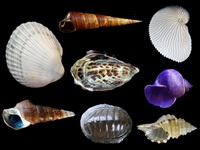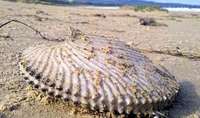Molluscs on the move
Dr Simon Grove, The Tasmanian Museum and Art Gallery, 17 Oct 2014.
Snails aren’t best known for moving at anything faster than, well, a snail’s pace. Yet out in the oceans, a seismic shift in the ranges of species seems to be gathering pace, with snails and their relatives at the vanguard.
The evidence for these changes is often dismissed as anecdotal, but now we have more solid evidence in the form of museum specimens. Many of the nation’s museums have collected mollusc specimens for decades. Using the details of such collections*, I have been able to construct maps plotting rapid changes in distribution over time for some mollusc species in Tasmanian waters. These demonstrate three main patterns of change.
The first pattern – familiar to contributors to Redmap – is for warm-water species to be turning up south of their previously known ranges. For Tasmanians not used to seeing tropical species, these changes are exciting. Who would have thought, even a few years ago, that the beautiful shells of greater argonauts (or paper-nautilus) would be washing up on southeast Tasmanian beaches? The common paper nautilus, Argonauta argo, is more at home in Queensland and New South Wales, yes; but Storm Bay on the Tasman Peninsula in south east Tasmania? The same goes for the ocean-going violet-snails: this decade has seen a historically unprecedented influx of the beautiful warm-water globose violet-snail, Janthina exigua.
Both these new arrivals have been turning up in late summer and autumn, and seem to have been brought to Tasmania from further north by eddies of the strengthening warm-water East Australian Current. It’s worth noting, though, that their venturing into Tasmanian waters is currently a one-way journey: at the onset of winter the strength of the current diminishes and the animals become stranded in waters that are too cold for their long-term survival.
 Molluscs.jpg)
Photo (above): Some molluscs on the move in Tasmanian waters. Top row - species moving south: greater argonaut (paper-nautilus); globose violet-snail; hairy rock-whelk. Middle row – introduced species: New Zealand screw-shell, Pacific oyster and green chiton. Bottom row – sub-fossil species: mud-ark shell and Hercules’ club.
Meanwhile, larvae of the hairy rock-whelk Monoplex parthenopeum - a predatory sea snail that is common enough in New South Wales to be a pest to oysters - have been settling out as snails on rocky reefs further and further down the east coast of Tasmania. As yet, no fully adult snails have been found, but it seems only a matter of time.
The second pattern is almost the reverse of the first: there are warm-water species which used to occur in Tasmanian waters thousands of years ago but which now only live much further north, in New South Wales and Queensland. We only know that they used to occur in Tasmania because their shells still wash up on local beaches. But these shells are sub-fossils that have been washed out of sediments by a shift in local currents. The species concerned – including the large creeper known as Hercules’ club Pyrazus ebeninus (another sea snail) and the mud-ark clam Anadara trapezia – are today typically denizens of mangrove forests! Their occurrence on Tasmanian beaches demonstrates that for a period many thousands of years ago, the local waters were significantly warmer than they are today.
The third pattern is in many ways still the most insidious, since there is little chance of reversal. It concerns temperature-tolerant introduced pest species, which continue to spread beyond their original point of introduction, usurping living-space from natives as they do so. The most rampant examples in Tasmania are Pacific oyster, Crassostrea gigas, and New Zealand screw-shell Maoricolpus roseus.
.jpg)
Above: distribution of museum records of Pacific oyster Crassostrea gigas around Tasmania. The red dots show points of original introduction; the blue dots show the species’ subsequent spread (Dr Simon Grove).
The oyster was first established in the early 1950s in Pittwater near Hobart and in Port Sorrell, but our records show its gradual colonisation of suitable shorelines along much of the Tasmanian coast since then. The screwshell probably arrived in the Derwent in the 1920s or 1930s with sacks of oyster spat from New Zealand. In Tasmanian waters it has since spread progressively northwards up the east coast and then eastwards along the north coast. Bass Strait has proved no obstacle to its colonisation, and it can now be found from Sydney to South Australia. In many places it forms dense aggregations down to a depth of at least 200 m.
Some generalisations can be drawn from these analyses. The first is that the ‘winners’ tend to be species with easy means of dispersal. The argonauts and violet-snails, for instance, spend their entire lives in open water and can travel at the pace of the East Australian Current. The hairy rock-whelk has planktonic larvae that can feed in the ocean currents for months before settling out, perhaps hundreds of kilometres from where their parents spawned. By contrast, the spread of green chitons, Chiton glaucus (another feral species which arrived at about the same time as the New Zealand screw-shell) has been relatively sedate, probably because they only have a very short-lived planktonic larval stage and so effectively have to crawl their way around the coast.
As Heraclitus noted over two thousand years ago, the one constant in life is change. Indeed, a warmer Tasmanian recent past may explain why there appears to be relatively few genuinely cold-adapted, warmth-shunning, mollusc species in our coastal waters. The difficulty for our native marine life today is less about change per se and more about its rapid rate. Only time will tell how much of the natural world will be able to keep up with the pace of human-induced change, and how much will fall by the wayside.
Dr Simon Grove is the Senior Curator of Invertebrate Zoology at the Tasmanian Museum and Art Gallery's Collections and Research Facility, www.tmag.tas.gov.au
Email: simon.grove@tmag.tas.gov.au | Facebook |Twitter
* Dr Grove’s findings are based on the mollusc collection details– the ‘where and when found’ – for those specimens in the Tasmanian Museum and Art Gallery, plus those appearing on Redmap and in the online Atlas of Living Australia.













